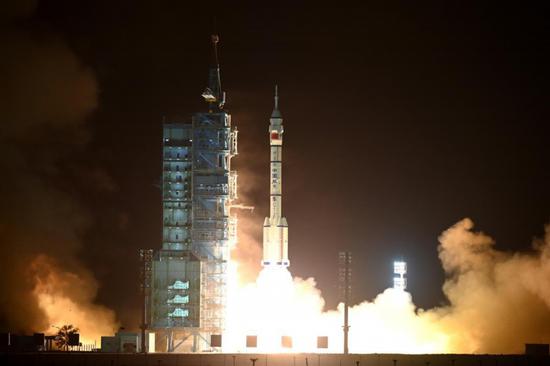 A Long March 2F rocket carrying the Shenzhou XVIII spacecraft blasts off from the Jiuquan Satellite Launch Center on Thursday. (Photo by WANG JIANGBO/FOR CHINA DAILY) A Long March 2F rocket carrying the Shenzhou XVIII spacecraft with three astronauts aboard blasted off from the Jiuquan Satellite Launch Center in Northwest China at 8:59 pm on Thursday. After separating from the rocket and entering orbit, the spacecraft was scheduled to conduct a fast automated rendezvous and docking procedure with the Tiangong space station. It was to dock with the radial port of the space station's core module Tianhe, said Lin Xiqiang, deputy director of the China Manned Space Agency, thereby forming a combination of three modules and three spacecraft, including the Shenzhou XVII spacecraft. It is China's first manned mission ever launched in April, which is typically the windiest and sandiest month at the launch center, so the meteorological staff analyzed April wind speed data from the past 10 years and mapped out multiple contingency plans for the launch. The Shenzhou XVIII crew members are Senior Colonel Ye Guangfu, who is the mission commander, Colonel Li Cong and Colonel Li Guangsu. After their peers from the Shenzhou XVII mission hand over the massive orbital outpost, the Shenzhou XVII crew will return to the Dongfeng landing site on Tuesday. Shenzhou XVIII is the 32nd flight mission of China's manned space program, and the third crewed mission during the application and development stage of China's space station. Yang Liwei, China's first astronaut in space and now one of the chief planners of the nation's manned space program, said he has high expectations for the post-1980 generation crew. "It's such a pleasure to see the young astronauts can now carry out manned space missions and take on the heavy responsibilities. I am sure the Shenzhou XVIII crew will do well, although the mission has become more complicated and tougher," Yang said at the launch center on Wednesday afternoon. Yang noted that it has been 21 years since he completed the Shenzhou V mission in 2003, during which he traveled in space for 21 hours and orbited Earth 14 times. "Since then, China's manned space programs have made steady and solid progress according to the plan. Currently, the operation of the space station has been normalized," Yang said. Lin, the China Manned Space Agency deputy director, said the Shenzhou XVIII crew will use the scientific experiment cabinets and extravehicular payloads to carry out more than 90 experiments involving microgravity, material science, life science, medicine and technology. Besides conducting China's first research on a self-cycling aquatic ecosystem, consisting of goldfish algae and zebrafish in orbit, the crew will also carry out the world's first in-orbit stem cell study to explore plants' evolutionary adaptation to gravity and provide theoretical support for space crops, he added. Lin said the Shenzhou XVIII astronauts will carry out two or three extravehicular activities and conduct six cargo outbound deliveries via the station's cargo airlock module. During the extravehicular activities, the astronauts will install space debris protection reinforcements for extravehicular piping, cables and critical equipment, and will conduct inspections, as appropriate, to further safeguard the safety of the space station. The Shenzhou XVIII crew members are scheduled to return to the Dongfeng landing site in late October after six months in space. |
Powered by Discuz! X3.4
© 2001-2013 Comsenz Inc.